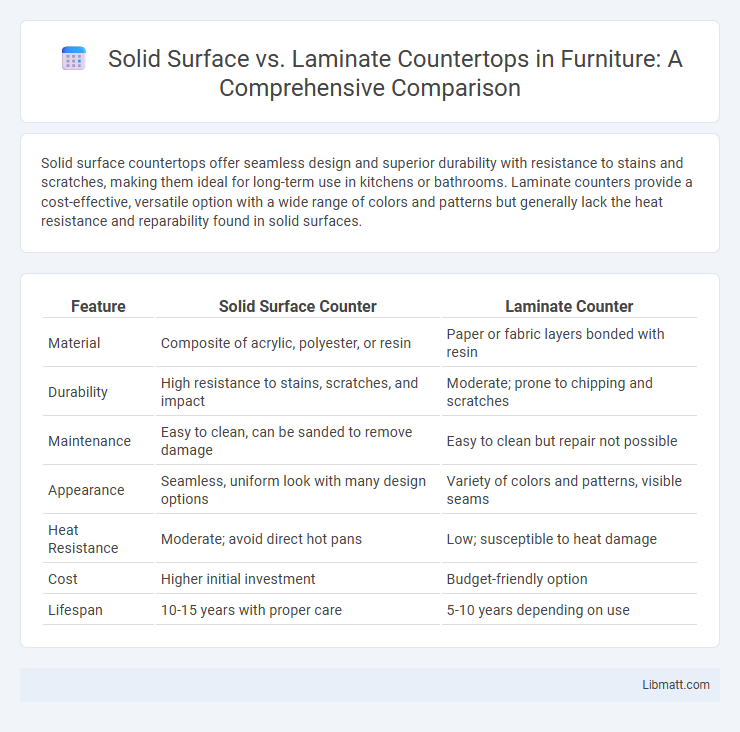Solid surface countertops offer seamless design and superior durability with resistance to stains and scratches, making them ideal for long-term use in kitchens or bathrooms. Laminate counters provide a cost-effective, versatile option with a wide range of colors and patterns but generally lack the heat resistance and reparability found in solid surfaces.
Table of Comparison
| Feature | Solid Surface Counter | Laminate Counter |
|---|---|---|
| Material | Composite of acrylic, polyester, or resin | Paper or fabric layers bonded with resin |
| Durability | High resistance to stains, scratches, and impact | Moderate; prone to chipping and scratches |
| Maintenance | Easy to clean, can be sanded to remove damage | Easy to clean but repair not possible |
| Appearance | Seamless, uniform look with many design options | Variety of colors and patterns, visible seams |
| Heat Resistance | Moderate; avoid direct hot pans | Low; susceptible to heat damage |
| Cost | Higher initial investment | Budget-friendly option |
| Lifespan | 10-15 years with proper care | 5-10 years depending on use |
Introduction to Solid Surface and Laminate Countertops
Solid surface countertops, made from a blend of acrylic and polyester resins, offer seamless joints and a non-porous, stain-resistant surface ideal for kitchens and bathrooms. Laminate countertops consist of a plastic-coated synthetic material applied over particleboard, providing an affordable and versatile option with a wide variety of colors and patterns. Your choice between solid surface and laminate depends on factors like durability, maintenance, and aesthetic preferences.
Material Composition and Manufacturing
Solid surface countertops consist of a blend of acrylic or polyester resins combined with natural minerals, creating a non-porous and seamless surface through a casting process. Laminate countertops are made by bonding layers of kraft paper and decorative plastic resin under high pressure and heat onto a particleboard or MDF core. The manufacturing of solid surfaces allows for easier repair and customization, while laminate production emphasizes cost-efficiency and a wide variety of aesthetic finishes.
Appearance and Design Versatility
Solid surface countertops offer seamless, non-porous surfaces with a smooth, uniform appearance and can be easily molded into various shapes, making them ideal for integrated sinks and custom designs. Laminate counters provide a broad spectrum of colors and patterns, including realistic wood and stone finishes, but feature visible seams and edges that limit design fluidity. The choice depends on prioritizing either the sleek, customizable look of solid surfaces or the cost-effective, diverse aesthetic options of laminate.
Durability and Resistance to Damage
Solid surface countertops offer superior durability and resistance to damage compared to laminate, as they are non-porous and less prone to scratches, stains, and heat damage. Laminate counters, while more affordable, tend to chip, peel, and show wear over time, especially in high-traffic kitchen environments. Solid surface materials like Corian can be sanded and repaired if damaged, extending their lifespan well beyond typical laminate surfaces.
Maintenance and Care Requirements
Solid surface countertops require minimal maintenance, needing only regular cleaning with mild soap and water and occasional polishing to remove minor scratches. Laminate counters are highly durable but can be prone to chipping and burns, requiring gentle cleaning with non-abrasive cleaners and immediate care to avoid moisture damage at seams. Both materials benefit from avoiding harsh chemicals and abrasive pads to maintain their appearance and longevity.
Cost Comparison and Budget Considerations
Laminate countertops typically offer a more budget-friendly option, with costs ranging from $20 to $50 per square foot, making them ideal for cost-conscious projects or temporary solutions. Solid surface counters, priced between $50 and $120 per square foot, deliver greater durability and repairability, providing long-term value despite the higher initial investment. Your decision should weigh upfront expenses against longevity and maintenance needs to best fit your financial plan and usage requirements.
Installation Process and Complexity
Solid surface countertops require professional installation due to their need for precise cutting, seamless joints, and proper curing of adhesives, resulting in a more complex and time-consuming process. Laminate countertops offer a simpler, more DIY-friendly installation, involving adhesive application and edge banding that can be handled with basic tools. Your choice between these materials should consider the installation complexity and whether you prefer a professional finish or a budget-friendly, easier setup.
Environmental Impact and Sustainability
Solid surface countertops offer higher sustainability due to their long lifespan and ability to be repaired and reshaped, reducing waste compared to laminate counters. Laminate counters, typically made from particleboard and plastic resins, have a larger environmental footprint due to lower durability and difficulty in recycling. Choosing a solid surface option can better align with your environmental goals by minimizing landfill contributions and promoting resource efficiency.
Popular Brands and Product Options
Solid surface counters from brands like Corian, LG Hi-Macs, and Avonite offer seamless designs with integrated sinks and wide color options, ensuring durability and ease of maintenance. Laminate counters, available from Formica, Wilsonart, and Arborite, provide budget-friendly choices with diverse patterns, including wood and stone looks, making them ideal for customizable styles. You can select from these popular product lines based on your preference for solid surface's non-porous quality or laminate's versatile, cost-effective appeal.
Choosing the Right Countertop for Your Needs
Solid surface countertops offer seamless designs with high durability, making them ideal for kitchens and bathrooms requiring frequent cleaning and resistance to stains. Laminate countertops provide an affordable, versatile option with a wide range of colors and patterns, suitable for budget-conscious renovations and light to moderate use. Select solid surface materials for longevity and repairability, while laminate is preferred for cost-effectiveness and easy installation.
Solid surface vs laminate counter Infographic

 libmatt.com
libmatt.com